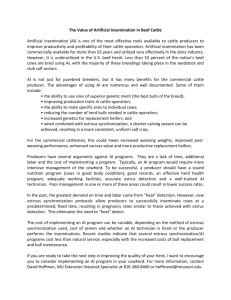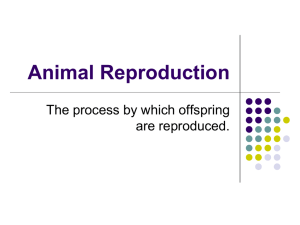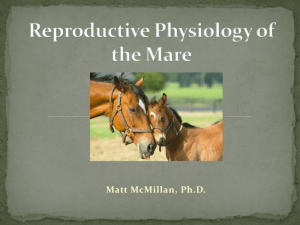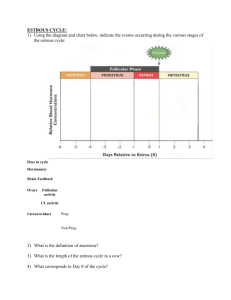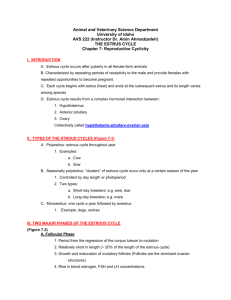Estrous Cycle in Cattle: Physiology & Endocrinology
advertisement
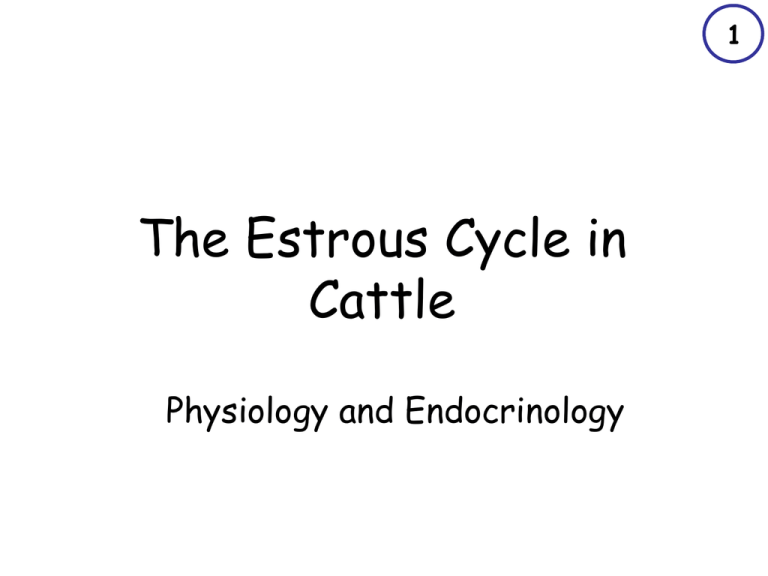
1 The Estrous Cycle in Cattle Physiology and Endocrinology Overview • Estrous cycle • Synchronization and benefits • Selecting hefers – RTS – Conditioning • Products and prices • Summation Estrous Cycle Length of the estrous cycle Average 21 days (range 18 to 24 days) Estrus (standing heat) 12 to 18 hours (range 8 to 30 hours) Ovulation Approximately 30 hours after the beginning of standing heat (or 12 to 18 hours after the end of standing heat) 2 Estrous Cycle Major structures on the ovary are … Follicle … a blister-like structure containing the egg (referred to as oocyte); produces hormone “estrogen” High amount of estrogen causes “standing heat” and “ovulation” Corpus luteum (referred to as “CL”) … looks like a hard yellow structure and produces hormone “progesterone” that is responsible for maintenance of pregnancy 3 4 Follicle Development Follicular Wave Regression Dominance Growth Selection Recruitment Next Recruitment Follicle development occurs as a wave-like pattern consisting of “Recruitment”, “Selection”, “Growth”, “Dominance”, and “Regression” phases Usually 2 to 4 follicular waves occur during the estrous cycle in cattle 5 Follicle Development Follicle Stimulating Hormone (FSH) Regression Next Recruitment Recruitment FSH FSH FSH precedes recruitment of follicles (causes follicles to start growing) FSH is the same hormone used for superovulation and embryo transfer in cattle 6 Follicle Development Luteinizing Hormone (LH) Dominance Regression Growth Selection LH pulses LH promotes further follicle growth and maturation of egg Follicle Development and Ovulation Luteinizing Hormone (LH) and Estrogen Ovulation Dominance Estrogen Growth Selection Estrus LH Surge LH stimulates follicle growth and a growing follicle produces high levels of estrogen High levels of estrogen, in turn, cause estrus and surge release of LH that triggers ovulation 7 Follicle Development During the Estrous Cycle 8 Example for 3 Follicular Waves 0 Estrus Ovulation Estrus Ovulation 2 4 6 8 10 12 14 16 Day of the Estrous Cycle 18 20 0 Length of the estrous cycle in cattle with 3 follicular waves is typically 20 to 24 days Follicle Development During the Estrous Cycle Example for 2 Follicular Waves 0 Estrus Ovulation Estrus Ovulation 2 4 6 8 10 12 14 16 Day of the Estrous Cycle 18 20 0 Length of the estrous cycle in cattle with 2 follicular waves is typically 18 to 20 days, slightly shorter than the estrous cycle with 3 follicular waves 9 Endocrinology During the Estrous Cycle 10 Follicle Stimulating Hormone (FSH) 0 Estrus Ovulation Estrus Ovulation FSH 2 4 6 8 10 12 14 16 Day of the Estrous Cycle 18 20 0 Example shown for cattle having 3 follicular waves during a 21-day estrous cycle Endocrinology During the Estrous Cycle 11 Luteinizing Hormone (LH) Ovulation Ovulation LH Surge Estrus Estrus LH Surge LH pulses 0 2 4 6 LH pulses 8 10 12 14 16 Day of the Estrous Cycle 18 20 0 Example shown for cattle having 3 follicular waves during a 21-day estrous cycle Endocrinology During the Estrous Cycle 12 Estrogen 0 Estrus Ovulation Estrus Ovulation Estrogen 2 4 6 8 10 12 14 16 Day of the Estrous Cycle 18 20 0 Example shown for cattle having 3 follicular waves during a 21-day estrous cycle 13 Corpus Luteum (CL) Growth and Regression Estrus Growth 0 2 4 6 Regression 8 10 12 14 16 Day of the Estrous Cycle 18 20 Estrus Ovulation 0 Corpus luteum develops from the ovulated follicle and takes approximately 10 days to reach mature size 14 Corpus Luteum (CL) Progesterone 0 Estrus Regression Estrus Growth Progesterone 2 4 6 8 10 12 14 16 Day of the Estrous Cycle 18 20 0 Corpus luteum produces progesterone Progesterone is responsible for maintenance of pregnancy after conception occurs 15 Corpus Luteum (CL) Regression Prostaglandin F2 (PG) 0 Estrus Regression Estrus Growth PG 2 4 6 8 10 12 14 16 Day of the Estrous Cycle 18 20 0 Late in the estrous cycle, uterus produces PG which causes regression of corpus luteum PG is the same or similar hormone in “Lutalyse®”, “Estrumate®”, “ProstaMate®”, and “In Synch®” Corpus Luteum (CL) Maintenance 16 When cow becomes pregnant … Growth Estrus Maintenance 0 Embryo 2 4 6 PG 8 10 12 14 16 Day of the Estrous Cycle 18 20 0 Presence of embryo blocks uterus to produce PG late in the estrous cycle which causes maintenance of corpus luteum and production of progesterone for pregnancy Progesterone regulates LH Pulses Luteinizing Hormone (LH) 0 LH pulses LH Surge Estrus Estrus LH pulses Progesterone 2 4 6 8 10 12 14 16 Day of the Estrous Cycle 18 20 0 Progesterone regulates secretion pattern of LH pulses and hence, follicular development 17 Endocrinology of the Estrous Cycle 0 Estrus PG Estrus Estrogen Progesterone 2 4 6 8 10 12 14 16 18 20 0 Day of the Estrous Cycle Relationships among estrogen, progesterone, and PG during the 21-day estrous cycle 18 0 19 Estrus Estrus Physiology and Endocrinology of the Estrous Cycle 2 4 6 8 10 12 14 16 Day of the Estrous Cycle 18 20 0 Relationships among structural and hormonal changes during the 21-day estrous cycle (example shown for cattle having 3 follicular waves) 20 Estrus Synchronization 21 Effective Estrus Synchronization Programs Shorten the AI breeding season Cows or heifers are in estrus during a predictable interval that facilitates AI Reduce time and labor required to detect estrus Result in more cows and heifers becoming pregnant early during the breeding season Progestin-based programs can induce estrous cyclicity in anestrous cows and prepubertal heifers (For example: MGA, or CIDR)* * Progestins are progesterone-like compounds that act like progesterone 22 Effective Estrus Synchronization Programs Result in older and heavier calves at weaning Will have beneficial effects on the next breeding season More cows and heifers calve early More days postpartum at the next breeding season Replacement heifers will be older 23 Effective Estrus Synchronization Programs Consider what happens during a restricted breeding season, based on the average 21-day estrous cycle: If cows or heifers are cycling when an estrus synchronization treatment is implemented and they exhibit estrus during the synchronized period, they would have 3 opportunities to conceive during a 45-day period or 4 opportunities during a 65-day period If cows or heifers are cycling but no estrus synchronization treatment is implemented, then they have only 2 (45-day) or 3 (65-day) opportunities to conceive If cows or heifers are not cycling at the beginning of the breeding season, they have even less opportunity to conceive Points to Consider When Using Estrus Synchronization 24 Estrus synchronization is never a substitute for: Nutrition Herd health Proper management Estrus synchronization should not be used as a crutch for poor management When administered appropriately, estrus synchronization is an effective reproductive management tool that can be used to facilitate AI Points to Consider When Using Estrus Synchronization Determine which females would make the best candidates before beginning estrus synchronization Successful application of estrus synchronization is easier to accomplish with heifers (no calves to work with) 25 37 Selecting Heifers for Estrus Synchronization Heifers should be of adequate age (cycling or close to reaching puberty) Heifers should be of adequate weight Developed to 65 % of projected mature weight Do you know the mature weight of your cows? Utilize reproductive tract score (RTS) to assess reproductive maturity 38 Timing of Puberty in Heifers Target weight: Heifers reach puberty at approximately 65% of their mature body weight Determine your desired weight at breeding, calculate the gain needed to meet that weight, and feed to meet it 39 Management Considerations for Heifers DO NOT use growth promoting implants in replacement heifers Implants may disrupt or impair normal development of reproductive organs Developing uterus is especially sensitive to growth promoting implants 40 Management Considerations for Heifers Reproductive Tract Scores (RTS) are determined by rectal palpation of the ovaries and uterus The RTS should be performed approximately 6 to 8 weeks prior to breeding season and/or approximately 2 weeks prior to beginning an estrus synchronization treatment 41 Reproductive Tract Scores (RTS) Ovarian Measurement (mm) Ovarian Length Height Width Structures RTS Uterine horns 1 Immature < 20 mm diameter No tone 2 20-25 mm diameter No tone 3 20-25 mm diameter Slight tone 22 4 30 mm diameter Good tone 30 5 > 30 mm diameter 15 18 > 32 Description 8 No palpable follicles Infantile 10 8 mm follicles Prepubertal 15 10 8-10 mm follicles 16 12 10 12 20 15 (more than 30 days to puberty) Peripubertal (within 30 days to puberty) Cycling > 10 mm follicles (Follicular Phase) CL possible CL present Cycling (Luteal Phase) Adapted from Anderson et al., 1991 42 RTS Measurements RTS No. of Heifers Weight (lb) Pelvic Height (cm) Pelvic Width (cm) Pelvic Area (cm2) Estrous Response 1 61 594a 13.9a 10.9a 152a 54 %a 2 278 620b 14.1a 11.2a 158a 66 %b 3 1103 697c 14.5b 11.4b 166b 76 %c 4 494 733d 14.7c 11.7c 172c 83 %d 5 728 755d 14.7c 11.7c 172c 86 %d a, b, c, d = P < 0.05 Note the relationship between increasing RTS, weight, and skeletal development determined by pelvic area Estrous response increased among heifers that were more reproductively mature at the beginning of estrus synchronization and/or breeding season Adapted from Patterson et al., 1999a 43 Relationship Between RTS and Pregnancy RTS No. of Heifers Pregnant Open Pregnancy Rate 1 53 31 22 58 % 2 762 610 152 80 % 3 3458 3014 444 87 % 4 3398 3006 392 89 % 5 2613 2331 282 89 % Higher pregnancy rates at the end of the breeding season were achieved among heifers that were more reproductively mature at the beginning of estrus synchronization and/or breeding season Randle et al., 2001 53 Prepubertal Anestrus Timing of puberty is controlled by … Age Weight Breed Season Many factors involved Develop heifers to approximately 65% of mature weight by the breeding season This will help them to attain puberty at the right time 55 Nutritional Anestrus Nutritionally stressed cattle will experience delays in return to estrus after calving Can be “managed” through Improvement in BODY CONDITION Proper feeding management Postpartum Anestrus 56 Induction of Estrous Cyclicity Bull exposure Prepubertal heifers Exposure of prepubertal heifers to sterile bulls (for example, vasectomized, epididyectomized … etc) for 60 to 80 days before the breeding season may hasten the onset of puberty (ranges from no effect to 70 days earlier) Izard and Vandenbergh, 1982; Berardinelli et al., 1978; MacMillan et al., 1979; Roberson et al., 1991 This procedure also shortens the postpartum period in anestrous cows however my concentration is on heifers Foote, 1974; MacMillan et al., 1979; Zalesky et al., 1984; Gifford et al., 1989 Products Currently Utilized in Protocols to Synchronize Estrus *** Price may vary depending on suppliers *** 28 Prostaglandin F2 (PG) Lutalyse®, Estrumate®, ProstaMate®, In Synch® Approximate cost is $3.00/dose (range $2.50-$4.00) Gonadotropin-Releasing Hormone (GnRH) Cystorelin®, Factrel®, Fertagyl® Approximate cost is $5.00/dose (range $4.00-$6.00) Melengestrol Acetate (MGA® Premix) Approximate cost ranges $0.14 - $0.40/day/head including carrier 14 days ($2.00-$5.60/head) or 7 days ($1.00-$2.80/head) EAZI-BREED™ CIDR® Cattle Insert (CIDR) Approximate cost is $8.00 (range $8.00-$10.00) Syncro-Mate-B® (off the market) 60 Prostaglandin F2 (PG) Prostaglandin F2 (PG) 61 PG causes CL regression No effect on anestrous cattle No induction of estrous cyclicity … No Jump-start Only effective during Days 6 (6 days after estrus) to 16 of the estrous cycle Lauderdale, 1972 Prostaglandin F2 (PG) PG regresses CL NO NO YES Estrus 0 2 4 6 8 10 12 Estrus 14 16 Day of the Estrous Cycle 18 20 0 62 Estrous Response Double Injection PG Program 77 Example shown is 14-day interval for PG injections % of cows in estrus 50 2 x PG 40 30 20 10 0 PG 0 < 24 36 48 60 72 84 96 108 120 > 120 Hours following second PG injection Modified from Stevenson et al., 2000 Single or Double Injection PG Programs $3.00 or $6.00 ($3.00/one dose) Advantages: Cost effective ($3.00 or $ 6.00) Easy to use Good fertility 74 Single or Double Injection PG Programs $3.00 or $6.00 ($3.00/one dose) Disadvantages: No effect between days 0 to 4 or 16 to 21 of the estrous cycle Improved effectiveness after day 10 of the estrous cycle Require heifers and cows to have CL (cycling) Require extensive estrus detection (minimum 7 days) No induction of estrous cyclicity (No Jump-start) 75 Possible Outcomes 76 Single or Double Injection PG Programs Estrous response: Varies depending on the degree of estrous cyclicity in the herd and the stage of the estrous cycle of an individual animal Single injection of PG … up to 40 to 60 % Double injection of PG … up to 50 to 80 % Timing of estrus: Before PG injection to 7 to 10 days after PG injection Peak response ranges from 48 to 96 hours after PG injection 98 Melengestrol Acetate ® (MGA ) MGA is a registered trademark of Pfizer Animal Health 99 Melengestrol Acetate (MGA) Orally active progestin, administered as a feed additive Blocks estrus and ovulation Acts similar to progesterone from CL MGA can induce estrous cyclicity in peripubertal (within 30 days to attain puberty) heifers and postpartum anestrous cows Currently, MGA and CIDR are the only progestins commercially available in the U.S. Patterson et al., 1989 100 Intake Considerations What type of carrier to use? Mix with grain source (example: cracked or ground corn) For example: MGA with ground corn ($0.15/day/head) Top dressing does not work well If cattle are on lush pasture, remove salt from pasture and include salt in MGA carrier 0.5 oz. Salt per cow and MGA in carrier ($0.30/day/head) Pellet form (very palatable) For example: MFA Cattle Charge® with MGA ($0.40/day/head) 101 Intake Considerations Need to provide adequate bunk space (18 inches per heifer, and 24 inches per cow) Make sure cattle come to bunk before start of feeding MGA If cattle are not used to bunk feeding, 1-2 weeks of warm-up bunk feeding is recommended MGA should be fed one time per day at approximately the same time every day Separate heifers from cows for MGA feeding Late-term pregnant cows should not be fed MGA • MGA can be combined with PG to improve results 106 Distribution of Estrus 3-5 days 7-10 days % of herd in estrus MGA-PG (for AI) MGA only (for Natural service) Adding the PG injection to the MGA program results in a much tighter synchronization of estrus Adapted from Patterson et al., 2000 Management Considerations Why Not Introduce Bulls Right After MGA Withdrawal? Less fertile estrus after 2nd estrus for MGA 7-10 days anestrous cows after short estrous cycle (more fertile) % of herd in estrus 107 2nd estrus for most of cows (more fertile) Suggested timing of introducing bulls (see page 104 and 105) 0 5 10 15 20 25 Days after MGA feeding 30 If bulls were introduced to the herd right after MGA withdrawal, they may be overworked during the less fertile estrous period after MGA withdrawal, but before cows express fertile estrus Natural Service with MGA Program 109 $2.00–$5.60 (MGA cost) Advantages: Easy to use Shortens the next calving season (ideal way to start AI program in the following year) MGA can induce estrous cyclicity in postpartum anestrous cows (Jump-start) Does not require cattle to be handled Natural Service with MGA Program $2.00–$5.60 (MGA cost) Disadvantages: Must have adequate bull-power At least 1:15 to 20 bull:female ratio for 2-year or older bulls Yearling bulls … consider decreasing the bull:female ratio Resulting calves may be of inferior quality and provide less genetic improvement for the herd compared to AI calves (depends on the genetic quality of the clean-up bulls) 110 Summation • Lots of programs – Many combinations of programs • Many prices • The numbers definitely show results – Earlier calving season – More time to return to Estrus – Increased opportunity to become pregnant • However due to expense and labor intensity this is not for everyone Bibliography • “Guide to Estrus Synchronization of Beef Cattle” CD Freddie N. Kojima, Ph.D.and David J. Patterson, Ph.D. Department of Animal Sciences University of Missouri Columbia, MO 65211
